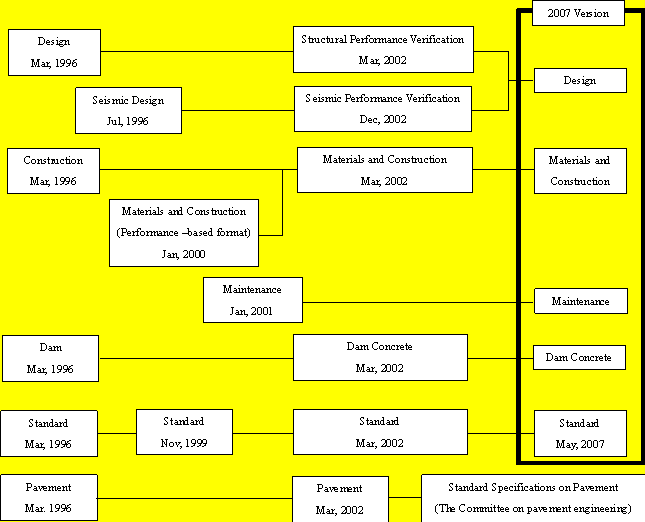|
|
| Revision history of Standard Spesifications for Concrete Structures |
The Standard Specifications for Concrete Structures has been accepted with
a great acclaim from users in various fields of design, construction, and
maintenance of concrete structures since the very first publication in
1931. As codes that define the way the planning, design, construction and
maintenance of concrete structure should be, it has contributing remarkably
to the development of concrete technology in Japan.
Taking into account recent developments in concrete technology not
only in Japan but also in the world, by the year 2002, the JSCE
Concrete Committee had modified all of the following parts from specification-based to performance-based standards.
- Structural Performance Verification
- Seismic Performance Verification
- Materials and Construction
- Maintenance
- Dam Concrete
- Pavement
The process of drafting and revising
different versions of the Standard Specification for Concrete Structures
in recent 10 years is summarized in the Figure shown below.

Fig. Revisions of Standard Specifications for Concrete Structure over the past decade
|
This time, the revision was carried out after a thorough consideration of the
above continuous processes, keeping in mind the minimum requirements for:
- Upgrading the developments in concrete technology since the year 2002, and
- Optimizing the current performance-based specifications
The main tasks of this revision are:
- Making the specifications convenient to practicing engineers
- Synchronizing all constituent parts so as to create a perfect connection between different parts
- Clarifying the responsibilities and roles of engineers, and
- Creating a basement for the engineer certification system of JSCE
The tasks listed above for this revision are based on the recognition that:
Standard Specifications for Concrete Structures is expected to have and
was created to provide detailed specifications on design and construction
of general concrete structures. This approach somehow satisfied the need
of practical users, but it also made the Specifications more difficult
to use. In addition, the requirements on the role the engineers play in
creating highly reliable concrete structures are gradually increasing.
Specifically, in gDesignh,h Materials and Constructionh, and gDam Concreteh
parts, while the General part stipulates the required performances, Manual
part introduces simple methods to achieve that required performances in
different given conditionsc In addition, in all parts including the Maintenance
part, the usage of each part (General and Manual ) and the mutual relation
among different parts are clarified at all stages of planning, design,
construction and maintenance.
It is believed that this revision is a fine integration between the rationality based on performance verification concept and the
practical applicability.
In this revision, the new set of the standard specifications
consists of five parts, gDesignh, gMaterials and Constructionh,
gMaintenanceh, gDam Concreteh, and, gStandards for Test Methods and
Material Qualityh. The previous Seismic Performance Verification and
Structural Performance Verification parts are integrated into a new
Design part.
The 2007 version of gStandards for Test Methods and Material Qualityh edition
was published in May, 2007. The revision of the Pavement part was completed
and published in 2007 under the title: The Standard Specification for Pavements
by the JSCE Committee on Pavement Engineering. The English version
of consists of 4 parts, "Design", "Materials and Construction",
"Maintenance", and, "Dam Concrete". |
|
|
|
|

